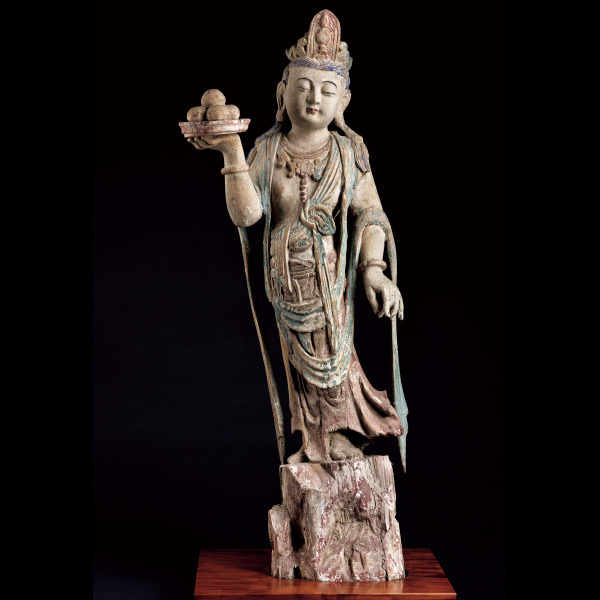
動画による作品解説
・年代:中国・宋時代(13世紀か)
・法量:総高103.1cm
Standing Statue of Bodhisattva
Era: China, Song dynasty (possibly 13th century)
Dimensions: Total height 103.1 cm
頭頂の髻から台座までを一材で造り、部分的に塑土を盛り上げて成型、彩色を施した菩薩立像。腰を大きく右に捻った弓形の体や、持った供物を支える盆を右方に差し出す姿から、もとは中尊の左右に配した脇侍菩薩像の一体で、本尊に対して供物を捧げる姿であったと思われます。
大づかみな造形は中国の石窟寺院に見られる石像に近く、台座を含む像全体を一木で彫出し、塑土を用いて細部を仕上げる手法、面貌や動きのある体勢は中国で宋時代に制作された仏像の特徴を示しています。体に比して頭部や手が過大な姿や、写実を離れて形式化した造形から、南宋(1127~1279)の時代に制作された像の可能性が高いでしょう。
A standing bodhisattva statue carved from a single piece of wood from the topknot to the pedestal, with parts molded and colored using clay. The body is significantly twisted to the right in a bow shape, and the figure extends a tray holding an offering to the right, suggesting it was originally one of the attendant bodhisattvas placed on either side of the central deity, offering to the main deity.
The rough carving resembles stone statues found in Chinese cave temples. The technique of carving the entire statue, including the pedestal, from a single piece of wood and finishing the details with clay, as well as the facial features and dynamic posture, are characteristic of Buddha statues made in China during the Song dynasty. The disproportionately large head and hands compared to the body and the stylized form departing from realism suggest that this statue was likely made during the Southern Song period (1127–1279).
